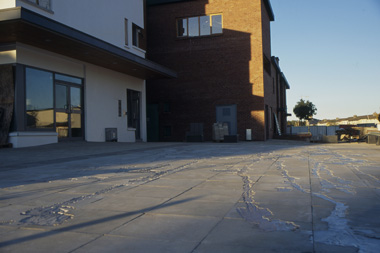Spaces can tell stories and unfold histories. Spaces can be interrupted and transformed through artistic and literary practices ’ (Bell Hooks)
 |
| Catherine Delaney: Fill; courtesy the artist |
In Sarajevo they used to fill the craters left from mortar attacks with a red liquid. These pavement wounds cast in a soft reddish resin are called the Sarajevo Roses. They make a strangely decorative pattern, – a street field of red roses – their glowing presence filled, not to seal up or smooth over, not to mend, but as a simple act of not forgetting. The brutalised landscape allowed to remain becomes a sacred site to close range memory – an unmonumental monument.
This is just one of the germs of influence on Catherine Delaney’s new work Fill, which was commissioned as part of Ballymun Regeneration’s highly acclaimed percent-for-art programme. Delaney’s inspiration does not involve a comparison of situations – Ballymun is not comparable to Sarajevo. Regeneration as a means of social ‘improvement’ is vastly different to picking up the pieces, to rebuilding a city after the war. Delaney’s cue from the ‘Roses’ has purely to do with her dual interest in casting and in memory, in not forgetting. The traumatic site in Sarajevo inspires only because it has allowed a leaving behind.
Fill is sited at Poppintree Lane, in front of Poppintree Neighbourhood Centre (about 1k walk from the flats). Delaney’s original plan was to create a temporary installation and work directly on the street, filling up the crack-holes using metal donated by the locals. However during the process – which was long and challenging (it took almost three years to complete) – her early ideas were revised and instead her installation was incorporated into the nearby and newly designed plaza. She translated the original site by making a cast of the street from traced drawings – marks, potholes, cracks, splits, tears, dents – the residual texture of constant traffic, the rough passage-scars left behind. The ordinary roadside, a piece of common property with its little histories scored in secret code, by movement, life and weather, has been cast in wax, the rain-pools then filled with liquid silver metal. Preserved. Transformed. Void is made solid, like Rachel Whiteread, who turns inside out, makes hollow concrete. Delaney’s street casts make the familiar (the street/road) defamiliar (a solid sculpture), emphasising the insignificant marks of lived space, re-asserting our relationship between place and time, past and present. A ghostly silver landscape forms, with entropy halted by the sporadic gestural splashing of pouring silver metal into ground-scars. Fill is a memorial to the overlooked. It carries within something elusive, so seemingly meaningless of a before, into the ‘new’ Ballymun. It resists a levelling of memory, suggesting that places need to keep their scars in order to preserve what our finite human memory will soon forget.
 |
Catherine Delaney: Fill ; courtesy the artist |
Ballymun was built by state officials and planners, as a major social housing scheme in the 1960s to relocate inner-city dwellers. It offered another solution for urban living, what was then considered the ‘utopian’ tower-block model, an upgrade, at least from the slumlike conditions of tenement living. To the outsider and over time, the tower blocks became landmarks – significations of alienation, ghettoization, and disillusion. Mistakes. In Ballymun, the village mentality, the intensively close relationships, the emergence of an articulate and active community, is tangible. Formed out of necessity, out of a marginalisation, out of close living and interdependency and out of a need to work against destructive undercurrents, the co-existence of an ‘outlawed’ other has made a place that matters to people. The inherent paradox is that the very living systems that contribute vitality and urgency to the ‘Ballymuner’ are being demolished (imploded) as part of an agreed process of revitalisation. It is not surprising therefore that the percent-for-art programme – Breaking Ground – undertaken as an integral part of regeneration, has offered a rich context for artists. Transformation presents a myriad of entry points. For Delaney (as for other artists such as Grace Weir, Andrew Kearney, Paddy Jolly), there exists within this potent landscape a poetic that is not for crossing out.
 |
| Catherine Delaney: Fill; courtesy the artist |
When you visit Delaney’s piece at the Popppintree Neighbourhood Centre, you might miss it at first unless you look down. Embedded within the pavement forecourt, Fill spills out, forming patterns of river-like tributaries. Its moonscape surface formed from the chance swirls and blobs of drying molten metal. Technically it pushes boundaries. Delaney knows her material and how to relinquish control. Her composition – the subconscious markings of molten substance flowing through street-scars – is an unmonumental monument.
Overlooked. Walked over. A low winter sun shines on the ‘nothing new’.
Cliodhna Shaffrey